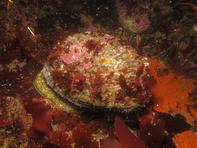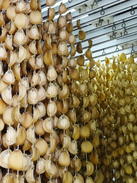Basically, a sea snail with a high export value, abalone or ‘perlemoen’ in Afrikaans, is endemic to the rocks of South Africa’s shallow coastal waters. ‘Perlemoen’ is derived from the Dutch term ‘Paarlemoer’ which means ‘mother of pearl’ referring to the shimmering colours and texture on the inside of an abalone shell.

Of the five species that are endemic to South Africa, Haliotis midae is the one that grows the largest and is the most suitable for marine farming.
Abalone is expensive seafood, considered a delicacy for its chewy and unique tasting flesh. It is one of the most expensive seafood products, in demand specifically in Asia, where it is highly prized for its medicinal, cultural and traditional value.
Abalone has a flat shell with corrugated edges, rather in the shape of an ear but with a flat wide opening, unlike the shells of land-based snails. It is part of a family of aquatic animals that includes clams, mussels, other sea snails and octopuses. Abalone move by means of a muscular ‘foot’, that moves in a wave-like motion. This’ foot’ also traps kelp, red and green algae, on which this herbivorous snail feeds. Abalone is therefore associated with the term ‘gastropod’, which means ‘stomach on a foot’.
Abalone from South Africa comes from two legal sources; it may be wild-caught by quota holders or is farmed on abalone farms. In South Africa in 2015, there were 18 abalone farms producing abalone. In the 2018/2019 season, 96 tons were allocated to quota holders for the harvesting of wild abalone.
Poached sub-standard abalone from South Africa is a serious threat to the legitimate abalone products available in the international markets, specifically China. In April 2019 it was estimated by the Minister of Agriculture Senzeni Zokwana that only 5% of South African wild abalone is legally caught.
Abalone Products

Abalone can be sold live, processed into canned products or dried. When exported alive, abalone is graded into sizes and packed into polystyrene boxes. Sizes can range from 50 - 70 g per unit to 200 - 300 g per unit. Live abalone is available all year round and shipped worldwide.
Abalone can be canned to either 425 g or 850 g weight and may contain between four and 22 pieces per can, depending on the weight. Abalone is cleaned and lightly brined.
Dried abalone is also produced in South Africa and may weigh from 25 g to 80 g per piece.
By Marinda Louw